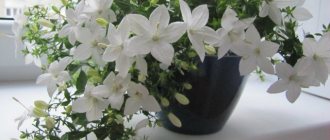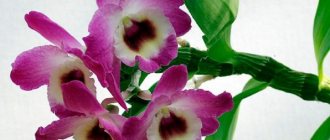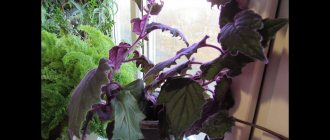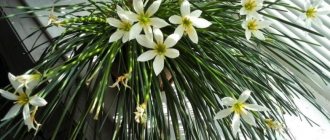Monstera is one of the most popular indoor plants. A beautiful evergreen vine with aerial roots and huge openwork dark green leaves on long petioles is grown by amateur flower growers at home as landscaping and interior decoration not only in apartments and houses, but also in the offices of reputable institutions and the lobbies of various administrative buildings. In this article you will find useful tips on caring for monstera and propagating in various ways.
Description
Monstera belongs to the Araceae family. The plant's homeland is considered to be the tropical forests of South America and the West Indies. Now it can be found in the tropical jungles of southern Brazil, Mexico, and India, where it grows, twining around some tall host tree. Under natural conditions, it reaches enormous sizes - up to 50 m in length, its carved leaves reach a meter in width. To climb tall trees in the wild, Monstera grows strong and long aerial roots, which, descending from the branches, reach the ground. If the vine loses its connection with the ground, it’s okay - thanks to its aerial roots, it will attach itself to the tree trunk and become a plant without roots - an epiphyte.
Even at home, the vine grows up to 6 meters in height (length) within four to five years.
Monstera is stunning with its beauty
Monstera looks impressive. Huge fans of dissected dark green leaves and cords of aerial roots are its distinctive features. Young leaves of Monstera have whole leaf plates, over time they become full of holes, and in an adult specimen the leaves are completely cut. The leaves do not lag behind the stem and grow up to a meter in length and up to 50 cm in width. Not only the appearance of the leaf is interesting, but also its internal structure. The lateral veins of the leaf plate are equipped with special organs - hydriators. When air humidity increases, they release droplets of clear liquid. The plant seems to be crying. It has long been noticed that Monstera usually cries a day before rain, i.e. is a natural barometer.
Watering, fertilizer
Caring for vines at home is not difficult. The plant does not require frequent watering, although it is moisture-loving. Monstera leaves are covered with a waxy coating and evaporate little moisture. Watering is carried out after the soil has dried from above, preferably with warm water.
Young plants do not need fertilizing, but adults need organic and mineral fertilizers 2 times a month during the warm seasons of the year.
Flower shops have a wide selection of fertilizers. For example, “Agricola 7”, “Nitrophoska”, “Lingogumat” and others. Before use, you should read the instructions.
Types of Monstera
About fifty species of monstera are known around the world. But only a few of them are grown at home. We will introduce you to them.
The leaves of Monstera deliciosa reach half a meter in width.
Monstera Deliciosa or Attractive (Monstera deliciosa) is the most popular type of plant. It is a fast-growing vine with dark green, pinnately dissected leaves in the shape of an elongated heart. This vine can grow up to 12 meters in height in the wild; in indoor conditions it is less - three meters. Thick cylindrical stems are up to 7 cm in diameter. The leaves are leathery, also of impressive size - up to half a meter wide. In countries with tropical climates, it is grown for its fruits, which are eaten there. Under favorable conditions of its maintenance, Monstera can bloom in our apartments, giving its owner a fruit very similar in taste to a ripe pineapple. Basically, Monstera Deliciosa is used for decorating and landscaping indoor spaces.
Currently, breeders have developed variegated forms of this species:
Alba (white-and-white)
Marble
Borziga
- The variegated white-variegated form of Monstera, also called Alba, does not grow quickly and is rather capricious in its maintenance. But it has incredibly beautiful leaves. They are the same openwork, but also painted with white patterns that extend over half the sheet. With age, these white marks become more and more numerous. The stem of this Monstera is also multi-colored.
- Monstera marbled is a variegated form of Monstera (Monstera variegata), combines green and beige (yellow) coloring of leaves and stems.
- Monstera Borsiga (Monstera deliciosa borsigiana) is a compact vine with smaller leaves (up to 30 cm) and thin shoots. Convenient form for indoor growing. Propagated by seeds.
Adanson
Punched (holey)
Oblique (unequal)
- Monstera adansonii is a long vine, up to 8 m, with large thin ovoid leaves up to 50 cm in length, on which there are many chaotic small holes. It is just beginning to gain popularity among gardeners, although it grows successfully at home.
- Monstera perforated or holey (Monstera pertusa) - this vine is large, with unequal, asymmetrically perforated lanceolate leaves up to 1 meter in length and 25 cm in width, expanding at the bottom.
- Monstera oblique or unequal-sided (Monstera obliqae) is a climbing vine with small (up to 20 cm in length and 5 cm in width) asymmetrical oval leaves on short, up to 12 cm, petioles. It is found in the apartments of amateurs, but is more often grown in greenhouses. It does not require support and can be grown in a hanging manner.
Dubia (doubtful)
Thin
Pointed
- Monstera dubia (dubia) is a rare variety of Monstera in the form of a miniature vine. Its leaves at a young age have solid plates with a silvery pattern along the veins and are similar to scindapsus leaves. As the leaves age, they become green and perforated. It is possible to grow without support, in the form of a hanging plant.
- Monstera acuminata is a compact indoor vine reaching three meters. The dense leaves are initially whole, with a sharp end. In an adult plant, small cuts appear on the leaves.
- Monstera slender is a rare vine. She is not big. Its leaves are delicate and lacy. The young vine has heart-shaped leaves without cuts. In adult plants they are pinnately dissected. It grows very slowly. Does not require support, grows like a hanging plant.
Step-by-step transplant process
How to replant violets at home
Transplanting monstera at home is a simple process that requires taking into account a number of features. It is necessary to study them in advance, after which the procedure itself will be simple and easy to implement.
To understand how to transplant a monstera at home step by step, it is worth considering the sequence of stages of the process:
- Combine together two parts of turf, one part of soil, one part of humus, one part of peat and one part of sand.
- Add one part of soil (leaf), crushed bark and peat (high peat).
- Add 0.5 parts of sphagnum moss and perlite.
- Sterilize the substrate, pebbles for drainage, and prepare the pot. The question of what kind of pot is needed for monstera is described above.
- Pour expanded clay into the bottom of the container. Instead, you can use perlite, pebbles, etc.
- Carefully remove the flower from the old pot so that the soil around the roots does not crumble.
- Carefully examine the plant itself (especially the root system). If there is damage, they must be removed.
- Place the monstera in a new pre-prepared pot and cover the roots with pre-prepared soil. Tamp it down a little to eliminate voids.
- Water the plant.
- Place the pot with the transplanted flower in a permanent place.
- Spray the leaves with additional clean water from a spray bottle to reduce replanting stress.
Monstera transplant
Flowering Monstera
Monstera blooms in the wild
Under natural living conditions, the liana blooms with a large, up to 30 cm in height, yellowish or cream-colored inflorescence, similar to an ear of corn, covered with a petal-veil. After flowering, the fruit, the berry, ripens for about a year. Monstera deliciosa has edible fruit. The pulp inside is juicy, reminiscent of pineapple in taste.
Edible fruit of Monstera
In captivity, Monsteras bloom extremely rarely and do not bear fruit. Perhaps the vine needs more humid air to bloom. In addition, fertilizing contains nitrogen, which stimulates the formation of green mass of the plant to the detriment of flowering. But you shouldn’t be upset - the flowers of the vine are not as good as the leaves. And not everyone has the patience to wait for the fruit to ripen - it would be possible to taste the taste of Monstera berries only in a year.
How to propagate monstera?
Indoor liana reproduces in three ways:
- by air layering - this is the easiest way of propagation; layering with at least one leaf plate and an aerial root is suitable for it; they are lowered into the ground to form an independent plant; they can be temporarily placed in plastic bottles to form roots;
- by cuttings - the use of lateral and stem shoots as material is practiced, the cuttings are rooted in pots under a glass greenhouse; before roots appear, the glass is lifted, ventilated and watered twice a day, and then transplanted into a larger pot;
- seed method - pots with sown seeds must always be kept warm and receive sufficient light. The first shoots appear after about 30 days. By the age of two years, an average of 9 leaves can be counted on a plant.
How does it bloom?
The flowering of vines with large white flowers occurs mainly in the natural environment; the flowers look like the sails of a yacht or the cap of a small gnome. Corn-cob-like fruits then appear, which turn purple when fully ripe. In the delicious monstera, these fruits are suitable for consumption.
The monstera plant blooms, extremely rarely, flowers appear in greenhouses and winter gardens. When grown at home, it is almost impossible to observe exotic flowering.
The benefits and harms of the plant
Superstitious people are afraid to grow Monstera at home. It’s not for nothing, they say, that its name comes from the word monster, monstrosity. In the 18th century, when Europeans had just begun to settle in Latin America, rumors appeared that giant killer plants lived in the jungle. Pioneers found human and animal remains laced with the stems and roots of these vines. They believed that plants attack the living and kill them. But the truth was that this vine could easily grow through anyone who got lost and died in the jungle. It is believed that it was because of these tales that the innocent vine was named Monstera (monstrum), which means monster in Latin.
This may be interesting: Guzmania (Guzmania) - description, types and varieties
In other sources, the plant's name comes from another Latin word (monstrosus), which means bizarre or amazing. And this is more fair. Knowledgeable people and experienced flower growers are very fond of this miracle of nature. Monstera has a large number of useful properties that have a beneficial effect on the indoor microclimate. During the day, its large leaves release a lot of oxygen and promote the evaporation of moisture, thereby humidifying the air.
It has been proven that this tropical beauty vine absorbs harmful electromagnetic waves well, absorbs formaldehyde fumes and promotes ionization of indoor air. At the energetic level, Monstera helps people in making any important decisions. It puts thoughts in order, develops a person’s intellectual abilities, and strengthens his immunity. Helps you calm down and concentrate on work. Thanks to these properties, Monstera can often be found in offices and institutions, in home living rooms and libraries. But you shouldn’t place it in the bedroom. At night, the plant’s photosynthesis process stops, so it begins to absorb large amounts of oxygen—this is unacceptable for a bedroom. In other cases, Monstera creates comfort and harmony around itself. And there is no hassle with growing it; it is an extremely unpretentious plant.
Construction of additional support for monstera
How to replant a cactus: options at home
In natural conditions, the monstera is able to find support for itself, which can be the trunk of any tree. At home, it is necessary to create a special structure for this. Proper support not only allows you to beautifully shape the plant itself, but also provides the opportunity to freely approach the plant for watering or feeding. The stand must be installed at the moment when the length of the stem has reached 0.5 m. It is then that it begins to deviate slightly to the side, after which it will be difficult to straighten it without spoiling it.
Note! Various sticks can be used to support the plant. It is recommended to wrap them with coconut fiber first. In flower shops you can purchase ready-made supports for monstera using coconut fiber.
You can build the support yourself at home. The sequence of steps for making a hand support is as follows:
- To make it, you should purchase a small plastic pipe that is hollow inside. They are installed individually depending on the dimensions of the vine itself.
- Holes of the specified diameter are drilled in the purchased pipe.
- The pipe is installed in a permanent place in the pot.
- The plant is transplanted into a pot with a pipe.
- Through the upper hole, expanded clay and sand are poured into the pipe to the level of the soil in the pot. This process will prevent rotting and mold in the pot and pipe.
- Pour peat and moss inside through the upper hole in the pipe (pre-mix in equal proportions).
- The support should be wrapped in moss and secured.
- Install a plastic mesh with cell sizes of 10-20 mm on the pipe.
Important! One main feature should be taken into account: you need to water the support installed in the pot (the contents of the tube) through the hole on top. Such a design will humidify the air well, and the aerial roots of the monstera will receive additional water, while the stem itself will remain straight.
To further strengthen such a structure, if necessary, you need to make parallel holes in the lower part of the pipe, through which strong plastic sticks should be passed. They need to be arranged crosswise.
Additional support for monstera
Monstera and Philodendron. Similarities and differences.
Monstera is often confused with Philodendron with dissected leaves. They are close relatives, both from the Araceae family. Philodendron leaves are more elongated and pointed at the end. But the main difference is that these plants have different juices. In Monstera it is transparent, and in Philodendron it is milky. It’s easy to make sure which plant is in front of you - break off a piece of a leaf or cut a shoot.
By the way! There is also an article about Philodendron on our website, which we recommend reading at the link. You might also like it.
Is it possible to keep a monstera at home?
Travelers first spoke about this unusual South American plant at the end of the 15th century.
Flora lovers are afraid to breed monstera in the house. The reputation of this unusual plant is denigrated by many myths, signs and superstitions. The name of the vine is translated as “bizarre”, “amazing”.
Superstitious people compare monstera to a monster. It is believed that philodendron can suck a person’s energy, thereby destroying a family, career and weakening the health of the owner. And yet, is it possible to keep a monstera at home?
It is definitely possible, even necessary. Stories about the negative properties of the flower and scary stories about the green vampire are greatly exaggerated.
Caring for Monstera at home
Caring for the plant will not cause any difficulties even for beginners. The useful tips that we will now offer you will help you care for Monstera yourself and keep it healthy and attractive all year round.
Lighting
Monstera prefers bright but diffused light
Monstera prefers moderation in everything. It does not grow well in heavily shaded areas, but it will not survive in direct sunlight for long. Prefers bright but diffused light and partial shade. The best place for a pot with a plant is on a stand next to east or west windows. In southern directions, the monstera should be moved away from the window deeper into the room or shaded, especially at midday. The leaves may get burned, become pale, covered with yellow spots and lose their attractiveness. Northern windows may not have enough natural light. You will notice this from the leaves - they will become smaller and smaller and without the openwork cuts so characteristic of Monstera. Move the flower to a more illuminated place or purchase a phytolamp or fluorescent lamp to provide additional lighting for the vine.
Flower location
Keep in mind that Monstera does not like to be moved from place to place. Immediately think about where it is best for it to grow. If you place the pot right in front of the windows, you will soon stop seeing anything behind the window glass. The leaves will unfold so much that they will cover most of the window, and sunlight will stop entering the room. It is better if you place a pot with a vine at a distance of one and a half meters from the window near the wall on some table, and behind it on the wall you organize additional, preferably fluorescent, lighting, which you will turn on if necessary.
Monstera takes up a lot of space
For an adult plant, you will probably need a support or fastening to the wall. In nature, the liana finds support for itself. It entwines tree trunks, climbing them with the help of aerial roots higher towards the sun. At home, you yourself must take care of support for a powerful pet. Otherwise, under the weight of its shoots and leaves, it will bend and break. Without support, it will not be possible to grow a harmonious and healthy plant. Usually, Monstera up to half a meter in height can easily do without support, but as soon as you notice that the plant’s stem has begun to deviate from the vertical, it’s time to install a support.
Flower shops sell sticks wrapped in coconut fiber. In the first couples, they are suitable for young Monstera, but for adult specimens the layer of fiber is too thin and will not allow the aerial roots of the vine to grow into support. Often, a tropical guest is allowed to lean on pieces of furniture in the room, and fastenings are arranged for her directly on the wall (a wooden lattice or a strong twine along which she weaves). But then it becomes more difficult to care for the plant, and you can forget about transplanting.
Temperature
For successful cultivation of Monstera, moderately hot temperatures are suitable. At 20 – 25 °C the plant will grow quickly and look wonderful. At low temperatures, growth will slow down, and at 15 °C the flower will stop growing altogether. Monstera does not tolerate drafts and sudden temperature fluctuations - window frames must be sealed. In winter, it is worth protecting the plant from the hot air of heating devices. And in winter it is advisable to maintain the temperature within 18 – 20 °C, since at higher temperatures it grows quickly. In the summer, when the temperature rises above 26 °C, you should spray the vine and the surrounding air with clean, settled water. To maintain a constant comfortable temperature in the room, you can use a split system, just make sure that the air flow is not directed towards the plant.
Bathing Monstera
Don't forget to wear gloves
Monstera's large carved leaves must be kept clean. Wipe them regularly with a damp cloth or sponge to remove dust. This should be done for several reasons:
- dust closes the pores on the leaves and disrupts the gas exchange of the plant with the environment;
- dust forms a film on the surface of the leaves, which slows down the processes of photosynthesis;
- dust can accumulate substances harmful to the plant;
- dust can hide traces of insect pests.
Also, if you spray the dusty leaves, it really does look like a spotted monster. So wipe Monstera leaves regularly, preferably in the morning. For greater beauty, you can add gloss to the foliage. Specialized stores have various products for polishing indoor plants. It's better to take it in aerosol packaging. But you can also polish with folk remedies. To do this, use beer, a weak solution of vinegar, or add a little milk to the water for washing the leaves. Do not touch the young foliage, but gently, but carefully, without pressing, polish the adult leaves with a cloth with the product of your choice. Liana will shine with beauty and health.
Watering and humidity
Monstera loves abundant watering from spring to autumn, and moderate watering in winter. It is unacceptable to overdry the earthen lump. The plant also does not like overflowing and stagnation of water in the pan - the root system can rot. Water with settled warm water.
This may be interesting: Syngonium - home care
For Monstera, it is advisable to maintain indoor air humidity above average - this guest is of tropical origin. But moderate indoor humidity, at least 60%, will suit her. Only, the hotter the air in the room, the more often it is necessary to carry out water procedures for the vine.
Soil and pot
The soil for indoor Monstera should be quite loose, retains moisture well, and is nutritious. The acidity of the soil should be neutral. The composition of the soil should be approximately this: 3 parts of turf soil, 1 part of leaf soil, peat, humus and sand. You can buy ready-made mixtures for decorative deciduous (Aroid) indoor plants, to which a little perlite or coconut fiber is added.
The pot should be approximately the same in width and height
Choose a pot that is approximately the same in height and width. For a young plant, the pot should be medium. For an older plant, choose a wider pot, since aerial roots will grow from each node of the plant and go into the soil. Place a 2–3 cm layer of drainage material at the bottom. This can be expanded clay, gravel, perlite, or foam chips.
Feeding and fertilizers
From March to September, Monstera can be fed with complex mineral fertilizer for decorative deciduous plants once every 2 to 3 weeks. It is better to reduce the dosage by 2 times, relative to what is indicated in the instructions - if the vine is actively developing, you should not overfeed the plant unnecessarily. For adult plants, once a summer you can add humus to the top layer of soil or water them with mullein infusion. If you cannot stand the smell of these fertilizers, limit yourself to ready-made fertilizers. In winter, there is no need to feed the plant.
Transplanting Monstera
For the first four years, young Monsteras need to be transplanted annually into a new pot, 3–4 cm larger than the previous one. After five years, an adult vine is replanted less frequently, once every 3–4 years, but the top layer of soil must be replaced in those years when replanting is not carried out.
Replant the young plant like this. Monstera needs to be replanted using the plant transshipment method. Remove the flower from the old pot with a lump of earth, being careful not to spill it. Inspect the roots; remove if damaged. Place the earthen ball in a new larger pot in the center. Place a support nearby. Pour in the new soil carefully, lightly compacting it. Water the vine, spray. Then take it to a permanent place.
Mature plants are more difficult to replant. The older the vine, the more land it requires. The pot has to be taken to grow - about one and a half to two buckets. It may be 6–10 cm larger than before. It is better to use ceramic pots - they are heavier and more stable, and a powerful plant will not tip over in them. The width of the pot should be sufficient so that Monstera's aerial roots can reach the soil. Do not forget to immediately install a strong support for the vine. Be sure to carry out the transplant with an assistant - you cannot cope with this alone.
Before transplanting, water the plant so that the soil is completely wet - then the roots will become elastic. Try to use a knife or spatula to separate the soil in the pot from the walls. If there are roots sticking out of the drainage holes, trim them. Now the hardest part is getting the huge plant out of the pot. You may have to climb onto a chair and drag the Monstera, holding onto its thick stem, while your assistant removes the pot from below. The new pot, drainage and soil must be prepared in advance.
Transfer the removed plant to a new pot, place it in the center and cover it with new nutrient soil so that there are no voids left in the pot. Don't forget to install the support. Water the soil. If the soil settles, add it. But not to the very top - otherwise, it will be difficult to change the top layer every year, and when watering, the water will overflow over the edges. Each time it becomes more and more difficult to transplant Monstera. Over time, you will only change the top layer of soil in the pot and add humus and other nutrients to it.
Caring for Monstera in winter
Monstera does not have a pronounced dormant period. She doesn't shed leaves. Only when the duration of daylight hours decreases and the temperature drops below 20 degrees. stops its growth. Monstera is able to spend the winter period at a temperature of 16 - 18 ° C with scanty watering and the absence of any fertilizing. It would be good to give the plant such a break for at least a month. As the temperature rises and daylight hours increase, even with the help of artificial lighting, Monstera will come to life again and begin to actively grow.
Pruning Monstera
The overgrown aerial roots of the vine do not always have a decorative appearance; you want to cut them off. But you shouldn’t do this - they serve to nourish and hydrate the plant. When spraying a vine, be sure to spray its aerial roots as well. Sometimes they are simply camouflaged, gathered in bunches, wrapped in moss or tied to a stem. Sometimes the roots themselves cling to the supports and grow into them.
Over time, an adult vine slows down its rate of development. To rejuvenate it and stimulate further development, in early spring, when the plant has not yet begun to grow, cut off the top of Monstera with two to three internodes, and treat the cut with crushed activated carbon. They are waiting for the lateral buds to awaken. And the top is used for propagation of Monstera by rooting it.
Flower arrangements featuring Monstera
Monstera gets along well with other vines. Philodendron and Scindapsus can grow in the same pot with it - you get an original ensemble. Their conditions of detention are similar. Next to the beautiful Monstera, such popular decorative foliage plants as ficus benjamina, palm-shaped dracaena marginata or yucca with long leaves look good. Chlorophytum, money tree or blooming Decembrist next to Monstera will also be a good decoration for your interior.
When can a young and mature plant be replanted?
Replanting a plant depends entirely on its age . Experts advise replanting a young monstera (it is considered up to 3-4 years old) every year; a middle-aged plant (4-5 years old) requires changing the pot once every 2 years, and after 5 years the break in replanting is 3-4 years. The main thing, in the latter option, is to replace the top part of the soil every year, and then the flower will delight you for many years.
Replanting provides new opportunities for growth, strengthens the immune system and allows you to maintain the health of the plant for many years. It is advisable to replant in early spring, since the active growth phase begins later, and serious changes can cause significant harm to the plant.
Monstera Reproduction
There are several ways to propagate this tropical beauty.
Seeds
The seed method is rarely used. At home, Monsteras bloom very rarely, and it can be impossible to get your seeds. If you nevertheless become the owner of tropical vine seeds, then sow them in containers with a mixture of sand and peat in equal parts, germinate under film in a warm, bright place at a temperature of 20 - 25 ° C. Ventilate the greenhouse and, if necessary, moisten the substrate. Shoots will appear in three to four weeks. Seedlings first appear undissected, juvenile leaves; only in the fifth to eighth month will true adult leaves grow. After they appear, pick the seedlings. A well-developed root system in plants grown from seeds is formed only after two years. At this age they will have 3–5 juvenile leaves and 2–4 adult leaves. Now you can transplant young Monsteras into suitable pots and place them in a permanent place.
Using side shoots
Propagating Monstera using side shoots is the easiest and most reliable way. It is used all spring to summer. Side shoots grow at the base of the plant stem. They are carefully separated, the sections are dried and powdered with crushed activated carbon or charcoal. The shoot prepared in this way is planted in a pot with a drainage layer at the bottom and suitable soil. Cover the pot with a plastic bag and place it in a bright, warm place for rooting. If necessary, the substrate is moistened and the greenhouse is ventilated. You will know about successful rooting due to the appearance of new sprouts on the shoots.
This may be interesting: Cordyline - types and varieties for indoor growing
Propagation by cuttings
Monstera can be propagated by cuttings with aerial roots. This method is used when the trunk of the vine is bald and it has lost its attractiveness. It's time for the monster to rejuvenate and get new plants at the same time.
To do this, select a shoot with aerial roots and at least one mature leaf. Without cutting the shoot, lower the aerial roots of the plant into a container of water to obtain normal small roots. When a sponge of roots sufficient to separate from the mother plant appears, the upper part of the stem below the roots is cut off and planted in a pot prepared for the young Monstera, while all the roots are buried entirely in the soil. Sometimes a new bush is planted in an old pot so that its leaves cover the exposed trunk of the mother plant.
Another method: the apical cutting with several leaves and a bud eye is cut from the mother plant and placed to root in a container with wet sand or a mixture of sand and peat, under a film. After about a month, when the roots grow, the cuttings are transplanted into pots with soil and cared for according to all the rules. At the same time, the mother plant continues to grow further. New shoots grow from dormant buds.
You can also take cuttings from the middle of the shoot. Make the top cut 2 cm above the bud, straight, and the bottom cut oblique. Lightly dry the sections and dust them with crushed charcoal. After this, the cuttings are planted in a substrate of peat and sand in equal parts. To maintain constant humidity, cover the container with a transparent bag. Ventilate and, if necessary, spray the substrate and cuttings. When planting, make sure that the node from which the aerial roots emerge is half immersed in the soil.
We do not recommend rooting Monstera cuttings in water.
We do not recommend rooting cuttings in water, since the roots that grow in it will take a long time to adapt to the soil and will not be able to extract nutrients and moisture from it for some time. Until new roots grow, the plant will hurt.
Keep in mind that Monstera sap is poisonous. It can cause skin dermatitis and irritation of mucous membranes. Use gloves when working with the plant.
What you will need
In order to fully comply with the monstera transplant algorithm, prepare everything you need in advance. And this:
- the plant you will be replanting;
- nutrient soil;
- a pot with drainage holes;
- pebbles or expanded clay for drainage;
- scissors;
- alcohol-containing disinfectant;
- fungicide (activated or charcoal);
- water for irrigation.
If the pot you purchased for replanting the monstera does not have drainage holes, you can make them yourself. To do this, take a pencil and mark on the bottom of the pot those places (4-6) where there will be holes. Then take matches or a lighter and hold the pot over the fire source so that the flame hits exactly the right place. When the plastic begins to melt, take scissors, lightly press on the softened area and make a hole. Enlarge it by rotating the scissors clockwise and then cut off the protruding pieces of plastic. Make several holes in this way, and then wash the soot off the pot.
Diseases and pests Monstera
With proper care, Monstera is not affected by insect pests and rarely gets sick.
But sometimes sucking insects such as scale insects, spider mites, mealybugs and thrips still appear on the vine.
When a plant is infected with scale insects, it looks depressed, the beautiful leaves begin to turn yellow and fall off. A black coating appears on the sticky secretions of insects - this is the development of a sooty fungus. If you find the parasite at the very beginning, it can be removed mechanically using a cotton swab dipped in alcohol or soap solution. If a flower is massively damaged by pests, it will have to be sprayed with insecticides such as Aktara, Biotlin and others.
If the leaves begin to turn yellow and a cobweb appears on their back side, the Monstera has been attacked by a spider mite. This means the room is too dry and hot. It is necessary to correct the situation - increase the humidity, spray the plant and the surrounding air more often. And we need to start fighting spider mites. Give the plant a bath if possible. Water will wash away most of the pests. Treat Monstera with acaricides - Fitoverm, Akarin or Actellik. Read the instructions. Repeat the treatment as many times as indicated in it and at the required interval. Otherwise, you will not be able to cope with the tick.
If a plant is attacked by a mealybug, you will understand this by the appearance of the leaves - they will be covered with a white coating, especially young leaves and shoots. They will become deformed, dry out, fall off. If possible, bathe the flower in the shower and wash off all the parasites. If the plant is too large, try to wipe each leaf with a swab and soapy water. If there is a large concentration of insects, use insecticides: Fitoverm, Actellik and others.
Thrips multiply quickly in hot, dry air. The leaves affected by them become grayish-brown on top. Insecticides are used again - Aktara, Iskra, Biotlin and others. And indoors, increase the humidity in any way possible.
Among the diseases, root rot can be distinguished. The problem arises due to excessive or improper watering of the plant. Perhaps your pot is too large, the soil in which does not dry out and turns sour. The root system suffers from a lack of oxygen and begins to rot. This happens more often in the autumn-winter period at reduced room temperatures. The plant loses its elasticity, the leaves droop, turn yellow and fall off. To save it, remove the flower from the pot, free the root system from the soil, and inspect the roots. Rotten and damaged - remove. Treat the cut areas with manganese solution, sprinkle them with crushed coal and plant the Monstera in another smaller pot with a large drainage layer.
With insufficient nutrition, Monstera leaves will fade, turn yellow and dry out. Feed the flower with fertilizer for ornamental foliage plants, but in slightly smaller doses than indicated in the instructions.
If Monstera started crying, i.e. Droplets of water began to flow from the leaves, perhaps the soil in the pot is too wet. Thus, the plant gets rid of excess moisture. This process is also characteristic of other plants from the tropics, it is called guttation. Keep this in mind and next time water only when the soil in the pot is half dry.
If only the lower leaves begin to turn yellow, and the new ones become darker and smaller, it means that you are not watering the plant enough. He lacks moisture.
If Monstera has stopped growing, its leaves have become whole and small, it means that it does not have enough light. Perhaps you blocked the light with other flowers or put the pot in the far corner. In order for dissected large leaves to appear again, the flower should be placed in a brighter place or provided with artificial lighting.
With age, the leaves on Monstera begin to fall off - this is natural. If the plant is young, and the leaves have turned brown and dried out, the cause may be too dry and hot air in the room.
If the aerial roots of Monstera have become thin and soft, then the plant lacks moisture. Adjust the frequency and amount of watering, wrap the aerial roots with damp moss, and increase the humidity in the room.
If the leaves of a flower first become light green, then turn yellow, become colorless and, finally, transparent, there may be two reasons: an excess of lighting or, which is much worse, the disease chlorosis. Chlorosis is treated with iron chelate, which is sold in stores.
If the Monstera leaves feel like brownish paper to the touch, perhaps the flower has become cramped in its pot; it urgently needs to be transplanted into a larger pot with a nutrient mixture.
Pests, diseases, possible problems - table
Diseases and pests rarely affect the vine, but sometimes they cause its death. The plant's leaves may curl, fall off, turn yellow, and dry out.
| Plant diseases | External signs | Fighting methods |
| Chlorosis (carried by aphids and mites) | Yellowing of leaves, appearance of light spots. | Processing with phytofarm. Feeding. Maintaining cleanliness. |
| Root rot | Yellowing and wilting of leaves. | Regulating the watering regime. Removing rotten roots and sprinkling the cuts with charcoal. |
| Spider mite | The appearance of yellow spots and spots on the leaf blades. Falling leaves. Presence of white cobwebs. | Treatment with phytoferm or derris. Regular shower with warm water. |
| Aphid | Curling, deformation and drying of young leaves. | Treatment with insecticide against aphids and preparations with permethrin. |
| Shchitovka | The appearance of hard brown plaques on the back of the leaves, drying of the tips. | Repeated treatment with a damp cloth with soapy water and insecticide. |
Monstera for the home: good or bad
This exotic plant is perfect for growing indoors. Monstera is a real find for a home or city apartment, especially in a metropolis.
Monstera has the following beneficial properties:
- humidifies and enriches the air in the house with oxygen;
- absorbs small particles of dust, soot and dirt;
- phytoncides secreted by philodendron inhibit the growth and development of bacteria;
- absorbs formaldehyde released from construction and finishing materials;
- absorbs electromagnetic waves emitted by household appliances (modern refrigerators, electric stoves, microwave ovens, TVs, computers and other electrical appliances);
- can warn of natural phenomena; before a rain or thunderstorm, droplets of moisture appear on the leaves of the monstera.
Monstera is a kind of filter for harmful substances, pollution and electromagnetic radiation.
What does it look like, where and how does it grow?
Monstera is a large tropical plant that is distinguished by dissected leaves.
The growth point of this variety is located at the very top of the shoot. The foliage is not only large, but also fatty, fleshy, rich in color, shimmering in the sun.
The plant is absolutely unpretentious in care . But before you decide to breed a monstera, you need to take into account the fact that it grows quickly, so you will need to find a lot of free space for it. This plant is often used for shading.
Monstera is a vine, so to give it a vertical shape it is necessary to use special supports. This is necessary to reduce the area occupied by the crop.
At home, monstera leaf blades reach a length of 30 cm, but with prolonged growth they can be longer. This plant is ideal for warm winter gardens.
Reference! Under natural conditions, Monstera grows in Mexico and Brazil.
Monstera with white leaves is called Borziga . She first appeared in Mexico. The stems are thinner than the green variety, the leaves do not exceed 25 cm. Also suitable for indoor growing.
Monstera (flower): influence on humans
Is it possible to keep an orchid at home: options why it’s good or bad
Does Monstera have an effect on humans ? This is a question that gardeners have before making a purchase. The plant is considered an energy vampire, which absorbs the good energy of its owners and can negatively affect the aura in the house. In fact, Monstera will only bring benefit and joy to your home.
Myths about the influence on people associated with the flower
Each flower has its own history and legends associated with it. There is a myth that travelers in the rainforests saw the plant feeding on human flesh, after strangling people with its long roots. In fact, the roots could entwine long-dead bodies and skeletons.
Philodendron roots
Note! Many people are afraid to sleep in a room with monstera, knowing about its ability to absorb large amounts of oxygen. The flower will suck out all the oxygen, and the person will not be able to wake up in the morning. Philodendron absorbs only harmful impurities in the air and releases even more pure oxygen.
It is also considered a myth that the plant emits negative energy, which leads to problems in family and personal relationships, careers, failures, etc. It is better for suspicious flower growers not to get a monstera, since they will attribute all their problems to it. The plant will feel a negative attitude towards itself and will not be able to exist in such conditions.
Beliefs about the flower of other peoples
According to Feng Shui, the ancient Chinese science of energy flow, the flower helps to achieve calm, tranquility, and harmony. It will help its owner achieve success at work and career growth. Chinese teachings claim that the plant unites the masculine principle of Yang and the feminine principle of Yin, which reduces the flow of erotic energy. Therefore, monstera is not placed in the bedroom of a married couple.
Among the peoples of Southeast Asia, the plant is a symbol of happiness, health, longevity, good luck, and prosperity. Monstera in the house is specially placed by the bed of a sick person. The pot is also placed at the entrance to the house; it is considered the guardian of the hearth, preventing negative energy from entering the house.
For your information! In Australia and India, questions about whether the plant is poisonous disappear. In these countries, it is eaten with great pleasure and is even specially grown for consumption. The fruits of the flower are considered a particularly delicious dish.
Signs and superstitions about the monster
The unusual, terrifying name of a tropical vine is directly associated among people with the word monster. The huge size of the monstera and the bizarre shape of the leaves, reminiscent of tentacles, on a subconscious level cause hostility towards this flower and a feeling of fear.
Signs and superstitions associated with monstera in the house:
- Monstera cannot be grown in a house where there is an unmarried girl;
- in a house where a monstera grows there will be no harmony - husband and wife often quarrel;
- You can’t place Monstera next to your bed - you can die from suffocation;
- the plant feeds on other people's energy, including positive energy, and the owner of the monstera suffers from fatigue and often gets sick.
Not a single superstition has scientific evidence; to believe it or not - everyone decides for themselves.
Is monstera poisonous?
Monstera is not a poisonous flower. It will not cause significant harm to humans if you do not come into contact with the juice it secretes.
Important! The juice contains irritating active substances that, if ingested, can cause gastric bleeding. The potty should be kept out of the reach of children. It is also dangerous for animals that like to chew leaves.
The only problem with philodendron for humans is the presence of microscopic, thin needle-like formations that are located on the leaves. How dangerous is monstera when it comes into contact with the skin? Contact with mucous membranes and skin will cause a slight burning sensation and redness, but such symptoms quickly pass. After manipulations such as replanting or pruning, you should thoroughly wash your hands with soap. Or carry out all procedures, first putting gloves on your hands. These rules apply to all colors.
In the office
Is it true that monstera is a poisonous plant?
Particularly sensitive people may have an allergic reaction to the plant. The symptoms of the reaction are similar to allergies to dust, pollen, and animals. Itching, red spots, sore throat, and nasal congestion may appear on the skin. Antihistamines will help get rid of an allergic reaction, and any nasal drops will help relieve nasal congestion.
Monstera has more positive qualities than negative ones. It is not dangerous unless you eat the leaves on purpose. Before purchasing, you should study the information about the monstera plant: why you can’t plant it at home. Caring for it is not difficult, therefore, if you are not afraid of the size of the philodendron and its leaves, as well as the superstitions around it, you should discard all prejudices and purchase it. It will decorate the interior of large rooms in the apartment, as well as office premises.











